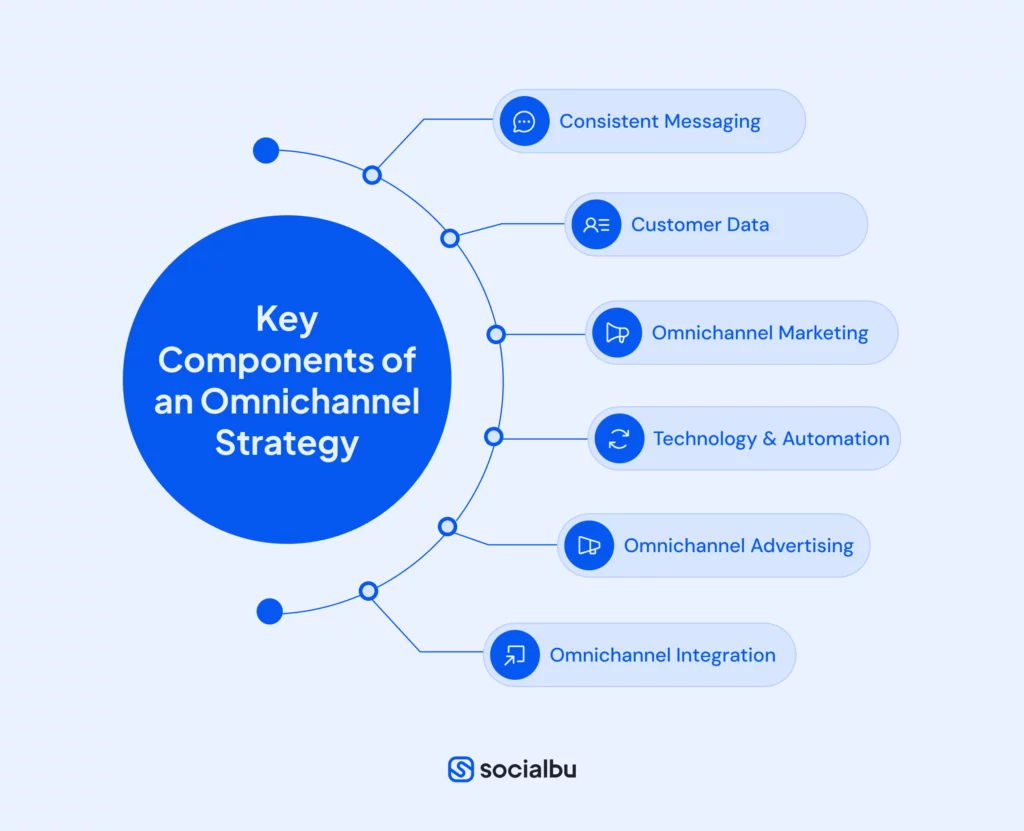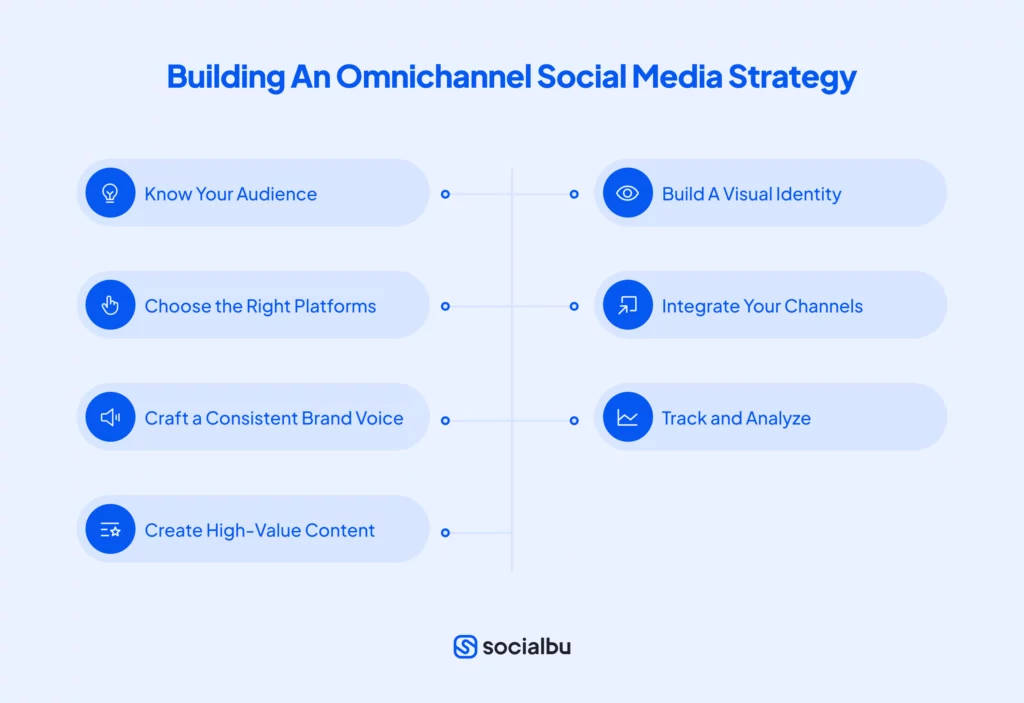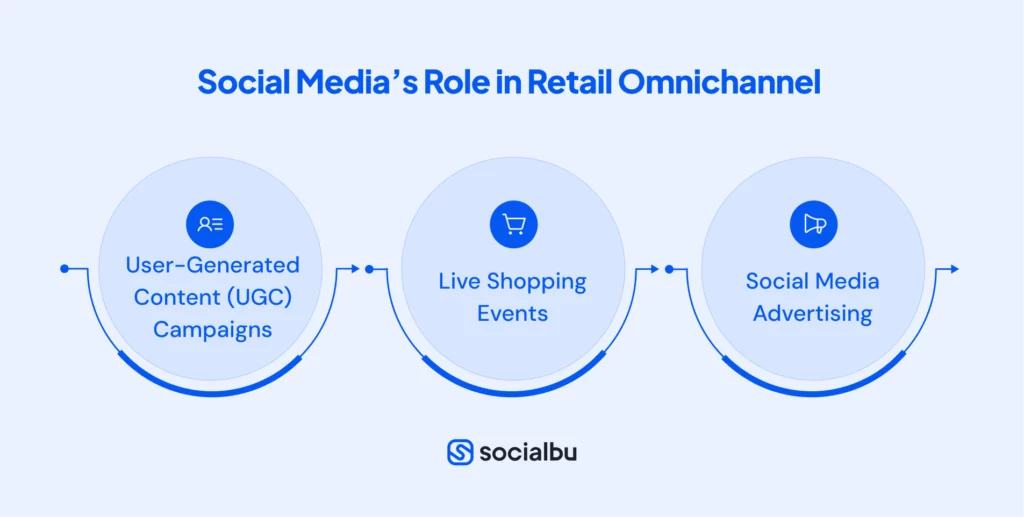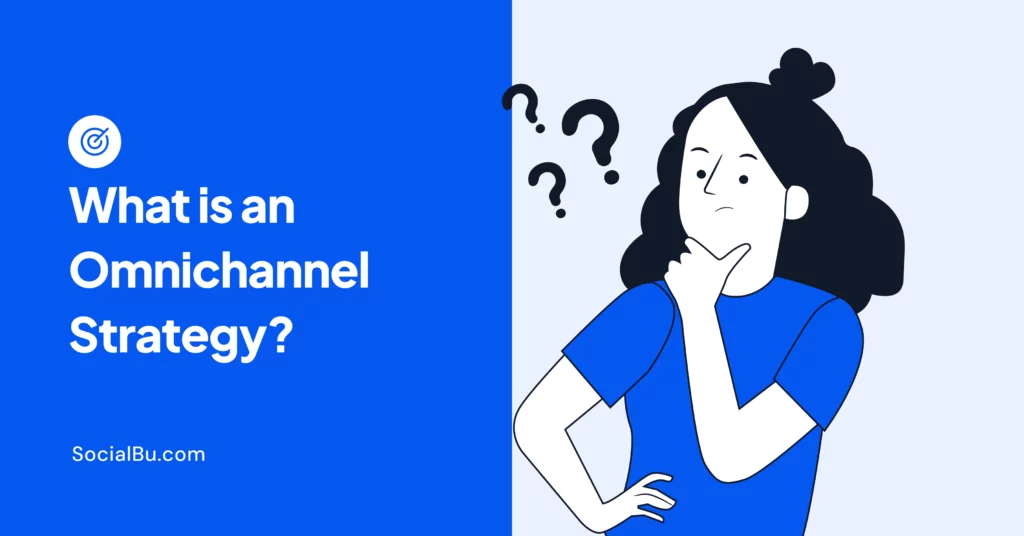Imagine a customer browsing your products on Instagram, visiting your website for a personalized discount, and finally purchasing at your store. That’s the power of an omnichannel strategy.
Omnichannel means providing customers with a smooth, connected experience across all platforms, whether shopping online, on a mobile app, or in a store. The goal is to ensure that customers get the same experience no matter where they interact with your business.
The omnichannel strategy helps you build a smooth customer journey that boosts brand loyalty and sales. This blog post will guide you through everything you need to know about building a winning omnichannel social media strategy in 2025.
We’ll explore key concepts, practical strategies, and real-world examples to inspire your approach. Let’s start and make the most of social media for your business!
What is an Omnichannel Strategy?
An Omnichannel strategy is a plan businesses use to reach and connect with customers through different channels, such as websites, stores, mobile apps, and social media. The main goal is to ensure that customers have a smooth experience no matter how or where they interact with the brand.
Why is Omnichannel the Way to Go in 2025?
Today’s customers expect a smooth experience across all platforms. If they see a social media post about a new product, they want to find it easily on your website. If they have a question after purchasing, they should be able to reach you through their preferred channel, such as social media, email, or live chat.
An omnichannel strategy ensures this seamless experience, leading to happier and more loyal customers. It also helps businesses use data to understand their customers better and make smarter decisions.
Key Components of an Omnichannel Strategy
An Omnichannel strategy includes several key components that help businesses easily connect with customers across different platforms.

1. Consistent Messaging
Omnichannel marketing ensures that the brand messages are the same across all online or in-store platforms.
2. Customer Data and Personalization
Gathering customer data from all channels helps businesses understand their customers’ preferences.
3. Omnichannel Marketing Campaigns
Running marketing channels across different platforms to reach customers everywhere.
4. Technology and Automation
Tools like CRM (Customer Relationship Management) software, chatbots, and AI help channels make their experience more efficient.
5. Omnichannel Advertising
This Omnichannel marketing strategy involves placing ads on different platforms, such as online, social media, or even in stores. This helps reach customers everywhere.
6. Omnichannel Integration
This means linking all your channels together. For example, your online stores, physical stores, and mobile apps. This is a big step in Omnichannel Integration to run things smoothly.
Building Omnichannel Social Media Strategy: Step-by-Step Guide
Now that you understand omnichannel’s power, let’s get down to business. Here’s a step-by-step guide to building a winning omnichannel social media strategy:

1. Know Your Audience
Before proceeding, take a step back and understand your ideal customer. Are they young and active on Instagram? Busy professionals who prefer LinkedIn? Knowing your target audience across different platforms helps you tailor your content and approach.
2. Choose the Right Platforms
Don’t spread yourself too thin. Choose the social media platforms where your target audience actively engages. When selecting, consider demographics, content type, and engagement levels.
For example, showcasing visually appealing products might be ideal for Instagram and Pinterest, while longer thought leadership content could shine on LinkedIn.
3. Craft a Consistent Brand Voice
Imagine your brand as a person with a unique personality. How do you want to sound on social media? Friendly and approachable? Professional and informative? Develop a consistent brand voice and tone that resonates across all your platforms. This builds brand recognition and trust with your audience.
4. Create High-Value Content
People crave engaging and valuable content. Develop a social media content strategy that mixes things up. Use high-quality images and videos to grab attention, but don’t forget the power of informative text posts.
Remember to tailor your content format for each platform. Keep it concise on Twitter and use longer-form storytelling on platforms like Facebook or YouTube.
5. Build A Visual Identity
People are drawn to visually appealing content. Maintain a consistent visual identity across all your social media platforms, including using the same logos, colors, and image styles.
A cohesive visual presence strengthens brand recognition and makes your content stand out in the crowded social media landscape.
6. Integrate Your Channels
Don’t let your social media presence exist in a silo. Integrate your social media channels with your website, email marketing, and customer service. Include links to your website in your social media bios, encourage social media followers to subscribe to your email list, and use social media for customer service inquiries.
This creates a seamless experience for your customers, no matter where they interact with your brand.
7. Track and Analyze
Social media is a powerful tool, but you must measure its effectiveness. Track key metrics like engagement, reach, and website traffic to see what’s working and what’s not. Use this data to refine your strategy and ensure you get the most out of your social media efforts.
Omnichannel Strategy in Retail
Retailers face a unique challenge in today’s digital age. Customers seamlessly switch between online browsing and physical stores throughout their shopping journey. An omnichannel strategy bridges this gap and creates a unified experience that drives sales and customer satisfaction.
Social Media’s Role in Retail Omnichannel
Social media platforms are powerful for retailers to connect with customers and showcase their products. Here’s how you can leverage them effectively:

- User-Generated Content (UGC) Campaigns: Encourage customers to share photos and videos of themselves using your products in real-life settings. This builds trust and authenticity, as potential customers see real people enjoying your products.
- Live Shopping Events: Host live shopping events on platforms like Instagram or Facebook Live. Showcase new products, offer exclusive discounts, and answer real-time customer questions. This creates an interactive and engaging shopping experience that drives sales.
- Social Media Advertising: Utilize social media advertising platforms to target specific demographics with promotions and personalized offers. Reach new customers, re-engage existing ones, and drive traffic to your website or physical store.
Examples of Successful Omnichannel Retail Strategies
Here are some real-life examples of successful omnichannel retail strategies:
1. Sephora
Sephora uses an omnichannel strategy, allowing customers to browse, purchase online, and try products in physical stores. Through its mobile app, shoppers can scan products in-store for reviews, tutorials, and more details.
2. Apple
Apple provides a fantastic customer experience across its physical stores, websites, and mobile app. Customers can schedule in-store appointments, purchase products online, or buy from the app.
Benefits of Omnichannel Marketing
Omnichannel marketing reaches customers across different platforms, such as websites, apps, social media, and even physical stores, to create a smooth and connected experience. Here are some key benefits of Omnichannel marketing.
1. Better customer experience
2. Higher customer loyalty
3. More useful data
4. More sales
5. Better brand recognition
6. More revenue
Conclusion
An omnichannel strategy is the future of customer engagement and brand success. Following the steps outlined above, you can create a cohesive online presence that fosters brand loyalty and drives sales. The key is to provide a smooth and positive customer experience across all your social media touchpoints.
Ready to take your social media to the next level and unlock the power of omnichannel? SocialBu can help.
Our social media management platform offers powerful tools to schedule posts, track analytics, and engage with your audience across all social media channels. Sign up for a free trial today and see how SocialBu can help you build a winning omnichannel strategy.
Frequently Asked Questions
1. What is an omnichannel marketing example?
Imagine a customer researching a product online, seeing a friend using it on social media, and then visiting the physical store to make the purchase. This seamless journey across different channels is an example of an omnichannel strategy.
2. What are the three core omnichannel strategies?
Unify Your Brand Voice and Identity: Maintain consistency across all channels, from messaging to visuals.
Integrate Your Channels: Connect your website, social media, email marketing, and customer service for a seamless experience.
Personalize the Customer Journey: Tailor your approach based on customer data and preferences.
3. What are the 4 C’s of omnichannel?
There isn’t a universally agreed-upon set of “4 C’s” for omnichannel strategies. However, some common focus areas include Content, Customer, Context, and Channel.
4. What is the omnichannel category strategy?
An omnichannel category strategy refers to how you approach specific product categories within your overall omnichannel approach. This might involve tailoring content, promotions, and the customer journey based on each category’s unique characteristics.






